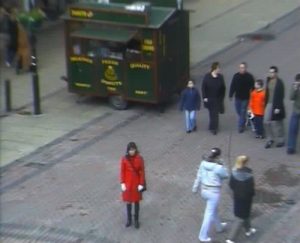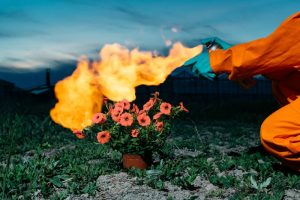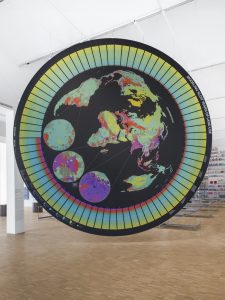Previously: Open City: Designing Coexistence – Part 1, Community
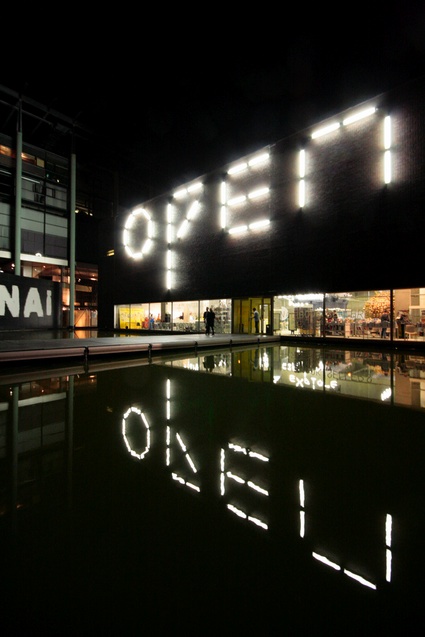 Exterior view of the Netherlands Architecture Institute (NAI) during the biennale. Photo © Michelle Wilderom
Exterior view of the Netherlands Architecture Institute (NAI) during the biennale. Photo © Michelle Wilderom
Open City: Designing Coexistence, the main exhibition of the 4th International Architecture Biennale in Rotterdam, has been sub-divided into seven areas of investigation. I reported on Community a couple of days ago. Now comes the turn of Refuge – Architectural Propositions for Unbound Spaces, curated by Phillip Misselwitz and Can Altay.
Refuge – Architectural Propositions for Unbound Spaces explores the causes and spatial impact of migration through voluntary or involuntary “refugees” who are transforming cities around the globe. Individuals or groups are elegantly or forcefully encapsulated from within the context of the city and society. Refuge produces an ever more atomized urban tissue where the “camp” has become both spatial paradigm and everyday reality, be it in the form of a gated community, slum, or humanitarian refugee camp.
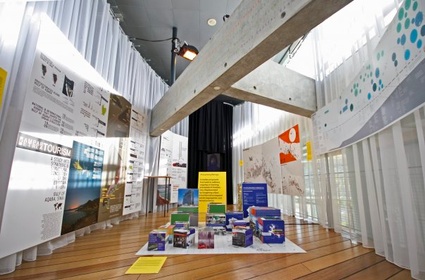 View of the exhibition about Refuge. Photography by Michelle Wilderom
View of the exhibition about Refuge. Photography by Michelle Wilderom
Refuge is subdivided into 4 categories, each illustrated by 3 examples found in various locations around the world. I picked up only one for each section of the exhibition.
Artist Thomas Kilpper opened the section Providing Refuge with a poetic and burning appeal to build A Lighthouse for Lampedusa! Providing Refuge explores how architects respond to the need of temporary spaces of refuge that offer protection to fragile or threatened constitutencies, or that legitimate expressions of a human desire for withdrawal, safety, seclusion and loneliness.
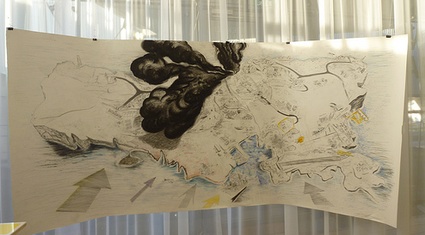
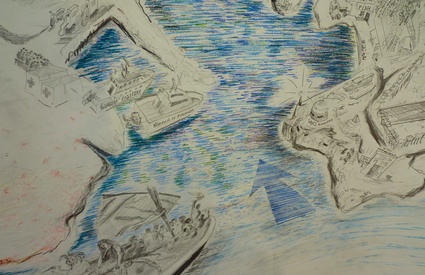 (detail of Thomas Kilpper’s drawing)
(detail of Thomas Kilpper’s drawing)
Every year, some 20 000 refugees, mostly from Africa, try to reach Europe via Lampedusa, a tiny Italian island between Sicily and Tunisia. Aid organisations estimate that one in ten die during the dangerous crossing. Once they’ve set foot on ‘the promised land’, immigrants are directed to a ‘Welcome Centre’ which inadequacy is creating a worrying humanitarian situation.
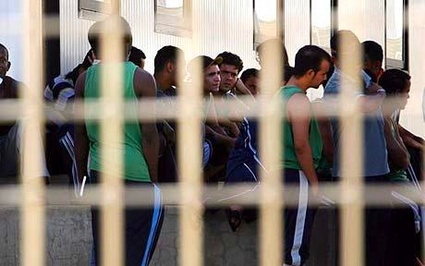 The illegal immigrant detention centre on the island of Lampedusa in Italy. Photo: Paul Grover
The illegal immigrant detention centre on the island of Lampedusa in Italy. Photo: Paul Grover
Thomas Kilpper, along with a team of architects, engineers and local people, hope to build a lighthouse with a powerful beam that would provide orientation at sea and help reduce the danger to life. Furthermore, the ground floor of the lighthouse would host an arts center. The discussions, exhibitions, concerts and other cultural events organized there would attract both new visitors to the island and local people, giving them an opportunity and space to learn from and listen to each other.
This project underlines the need for a solution to the refugee problem: it’s not possible to solve it via restrictions and declaring a ‘state of emergency’. We call for a humanitarian and just immigration and integration policy in Europe. None of the refugees is illegal. We oppose any idea to establish a ‘Fortress Europe’. The lighthouse will be a self-confident signal: ‘here we are, we do not hide’.
Preventing Refuge are proactive projects that aim to prevent entire groups of city dwellers from becoming refugees.
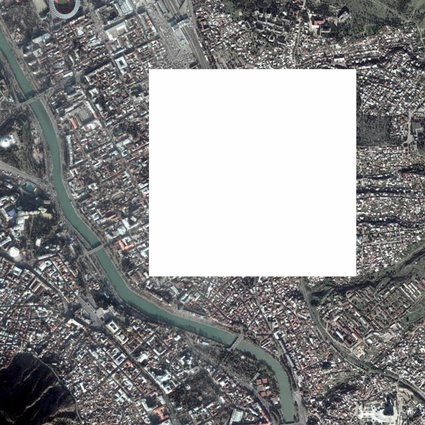 2 million square meters of development projected on the city
2 million square meters of development projected on the city
After the 2003 Rose Revolution, Georgia embraced a wild capitalism. Spatial planning became suspect, public assets were quickly privatized, and the city faced rampant land and property speculation, leaving the city authority without strategic plan. Some 2,000,000 m2 of newly developed areas threaten to destroy Tbilisi and led to large-scale urban displacement. A city already filled with thousands of war refugees has transformed citizens into refugees in their own city.
FAST, One architecture and local artists outlined a The New Map of Tbilisi to expose all spatial and infrastructural projects being imagined or built in the city, highlighting its lack of strategic coherence. It also shows how refugees from earlier civil wars and current residents are displaced. And, it tracks how public buildings, spaces, and parks were privatized, left to stand empty due to the crisis, then to be reclaimed by internally displaced persons.
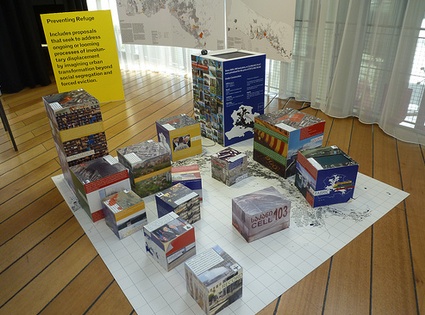
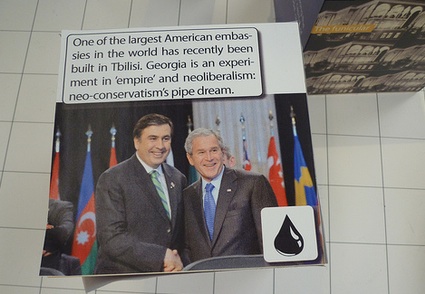
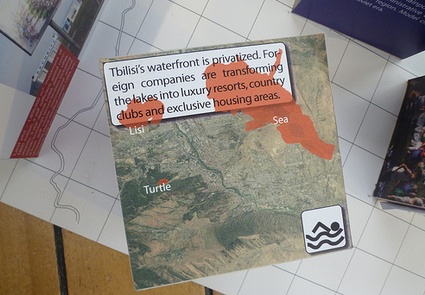
By exposing corrupt land deals and making the effect of failed statehood transparent, the “New Map of Tbilisi” aims to empower citizens to take positive action, providing a platform for grass root initiative, civil society institutions and municipal authorities alike to re-engage in a strategic discussion on the urban future of Tbilisi.
Laboratories of Returns, one of the projects i discovered in the Dismantling Refuge section, examines return from exile. When return becomes possible, the site of origins is already irrevocably transformed. Return is never a simple turning back of time, a return is always a return to the already built.
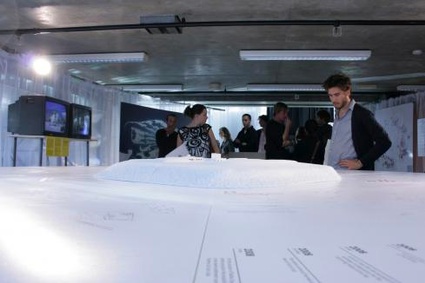 (image)
(image)
The notion of “return” has defined the diasporic and extraterritorial nature of Palestinian politics and cultural life since al Nakba in 1947-48. The work of Alessandro Petti, Sandi Hilal and Eyal Weizman urges architects to engage in a discussion about the revisiting, re-occupation, and appropriation of the already built. Their research and proposals on the appropriation of settlements and military bases to be evacuated -the “future archaeology” of Israel’s occupation — has been recently expanded to include other instances of displacement such as the afterlife of Italian colonial architecture in Libya.
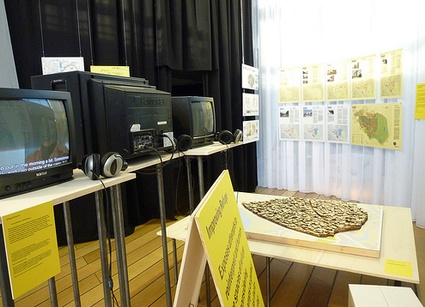 Improving Refuge focuses on the estimated 1.4 million Palestinians living in camps spread across Jordan, Gaza, the West Bank and Syria. These makeshift areas are among the most densely populated in the world. Living conditions, as we all know (but pretend to ignore), are abominable. Camps are a place of temporary-emergency refuge but they also need to be habitable. They hover between stillness and action. The Infrastructure and Camp Improvement Program launched by the UN attempts to introduce strong community-driven urban planning that would enable people living in the camp to go beyond the victim mentality.
Improving Refuge focuses on the estimated 1.4 million Palestinians living in camps spread across Jordan, Gaza, the West Bank and Syria. These makeshift areas are among the most densely populated in the world. Living conditions, as we all know (but pretend to ignore), are abominable. Camps are a place of temporary-emergency refuge but they also need to be habitable. They hover between stillness and action. The Infrastructure and Camp Improvement Program launched by the UN attempts to introduce strong community-driven urban planning that would enable people living in the camp to go beyond the victim mentality.
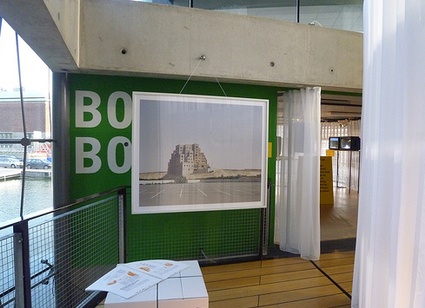
I found the practice of Participatory Community Mapping particularly fascinating. ARC, the Arab Resource Collective, invited Palestinians living in several refugee camps in Lebanon to collectively draw maps of their respective camps from memory. The resulting maps chart live experiences rather than the usual landmarks. Political fault lines, social affiliations, and the loci of power manifest themselves from the bottom-up. No only do these maps undermine derogatory assumptions about unruly spatial configurations, they also expose the glaring injustices of the Lebanese government’s policy regarding Palestinian refugees. The maps betray the absence of workplaces, except for grocery stores, mini-markets and pharmacies. In the writ of Lebanese regulations, Palestinian refugees are barred from performing dozens professions, including the practice of law, medicine, engineering, etc.
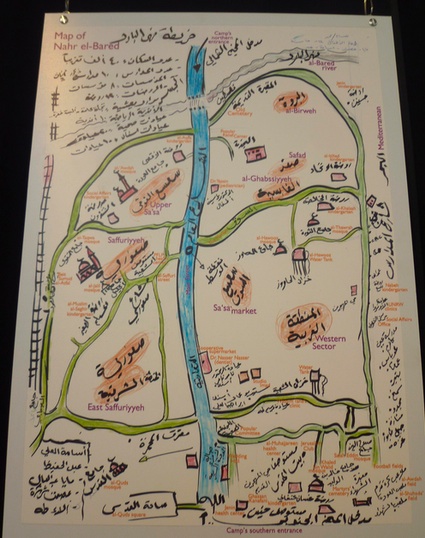 Map of Nahr el-Bared
Map of Nahr el-Bared
Open City: Designing Coexistence of the 4th International Architecture Biennale Rotterdam is on view until 10 January in the Netherlands Architecture Institute (NAI).
Photo on the homepage via EU Australia online.


